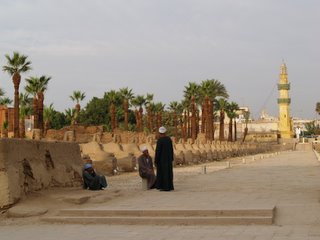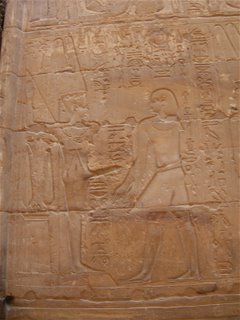
Luxor Temple, right on the banks of the Nile (in ancient Thebes), also dedicated to Amun, Mut and Khonsu (as is the Karnak: Temple of Amun) was completed around the 18th dynasty (the dynasty prior to Ramses II) which includes Hatshepsut (the first female pharoah)(1473-1458 BC) and Tutankhamun (1336-1327 BC) to name two.


This temple, like many others, was also buried under sand for many thousands of years. As a matter of fact, there is a mosque that is still used and it is built on top of the temple, and the original entrance is almost as high as the head of the Ramses II statue at the entrance! The temple was discovered in 1881, but before it could be excavated, the village that was built on top of it had to be removed (except the mosque). The mosque is called the Abu al-Haggag Mosque, built in the 1200's. Read the Temple of Karnak to find out why this name is important or at least interesting.
FYI, the row of sphinxes from Karnak to Luxor Temple is about 1.2 miles. The road is slowly being excavated and who knows, maybe the "avenue of sphinxes" will return.
The obelisk, which is pinkish, is 82 feet high. There used to be a pair, but the other one was given by Mohammed Ali (visit my Mohammed Ali Mosque photos) to the French government and is now in the Place de la Concorde in Paris.
Across the river from here is the Theban hills, where Hatshepsut's temple is built. See my posting for photos of that temple.

This particular relief is either Amenhotep III or of Amun and it depicts them as being fertile (no Viagra back then).

No comments:
Post a Comment